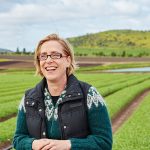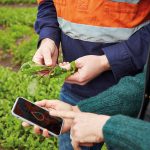
Extreme weather, bushfires, sheer scale: farming in Australia is tough. Finbarr Bermingham talks to the innovators using technology to make life easier.
Australia is a land of extremes. Of all the continental land masses, only Antarctica gets less rainfall. Yet, if you go to Bellenden Ker, a town near Cairns in northern Queensland, you’ll experience, on average, 7,950mm of rain a year – that’s almost twice as much as the wettest part of the UK, Crib Goch in Wales.
Temperatures vary from 40°C highs in the central desert regions to sub-zero in the higher regions in the southeast. The country experiences almost every climactic condition found elsewhere in the world, as well as a few unique to itself, according to the Bureau of Meteorology.
A difficult place to farm, you would think. Yet beef, wheat and cotton are among Australia’s most important exports. It exported almost 3 billion live cattle in 2017, beef and dairy, while Australian meat fetches a pretty price in eateries around Asia Pacific. Australia’s farmers need to be hardy and innovative, which explains why it’s becoming a hub for agricultural technology (agtech), a sector which has until now been dominated by the US.
“We’ve got such a range of growing environments in Australia it makes it a perfect place to develop agtech solutions. If it works here, it will work in any place in the world,” says Ben van Delden, head of agtech and markets at KPMG Australia.
His firm estimates that the global opportunity for agtech from the private sector is set to reach US$189bn by 2022. Global venture capital into the industry is currently worth US$1.5bn. On top of that, agriculture is tipped to become Australia’s “next US$100bn industry by 2030”.
“In the last three years, we’ve seen the rise of smaller startups bringing more nimble, affordable tech to market. But it’s still a frontier,” he tells GTR.
To date, much of the innovation in Australia has been backed by the government, mainly through the Commonwealth Science and Industrial Research Organisation (CSIRO). But more and more companies are springing up in the private sector. Agtech accelerators such as SproutX, Cultiv8 and Rocketseeder are exploring ways in which farmers and producers can improve their yields and make themselves more creditworthy. All of these make it easier for those at the start of the supply chain to access loans, insurance and other financial products.
Out in the fire
Some of the most interesting developments are coming from the farms themselves. James Walker is a fifth-generation farmer from Longreach, Queensland. He runs his Camden Park farm, which has 20,000 acres (for context: that’s big enough for 15,000 football pitches), some 1,117km from Brisbane. Much of the land is devoted to grazing sheep and cattle, but he’s also built a solar farm and boutique ecotourism homesteads.
Walker’s efforts to diversify have won him awards, but were necessitated by the worst drought in Australian history, beginning in 2014. “We’ve had to destock four times since I have been here – that’s no income out of the farm. Zero production, zero income. We had to get rid of everything,” he tells GTR down the phone line from Camden Park (or as he refers to it “out in the fire”.)
But perhaps the most extra-curricular project has been Agrihive, a company Walker founded, which subsequently launched Farmecco, a fintech solution. Farmecco is a cloud-based app that allows farmers to upload information about their operations, and within an hour turns around detailed financial reports. “It meshes production metrics with financial metrics as a way of improving financial literacy,” he says.
The solution gives farmers real-world scenarios on how to improve their performance, cash flow and sets key performance ratios. It is straightforward to use (GTR spent some time playing on a test account) and produces simple, yet detailed results. Farmers can take these reports to their accountants or bankers, as evidence of their financial health.
“We are onboarding financial products. But we’ve also got the insights so that if production improves, you’ve got intra-season leverage. You can draw a loan against the improved value of the inventory. You can also communicate your supply with the processor or end user, so they can give you a forward price, which will reduce the credit risk of that farm and drive better financial products to the farmer,” Walker says.
Perhaps most crucially, it can help farmers improve their financial agility, so that they’re better positioned to deal with times of drought, an unfortunate inevitability in Longreach and other parts of Australia. Walker’s own experience of dealing with dry seasons resonates with others in the business, he says. “It’s validated from someone who’s been in it. In some cases with agtech, the science is amazing, but they just don’t have the psychology of the farmer right.”
Currently, the company is working with accounting firms such as BDO – which is rolling out the solution to farming clients nationwide – and KPMG.
Walker says: “They want better tools to communicate their clients’ situations to financiers. So this is a tool that stakeholders can view and interact with to get a better understanding of the business. Everyone is dying for something that gives visibility of the farm, its production and its revenue generating potential to external stakeholders. Once we can nail and capture that, that’s the utopia.”
The world is your oyster
Other solutions are looking at ways of predicting the nasty weather scenarios which can be so detrimental to farmers’ output. Ros Harvey’s background takes in stints at the UN, the World Bank and the Tasmanian government. But for the past six years, she’s been focused on technology: namely, how can data analytics and sensing technology be used to improve decision-making in businesses.
In 2014, she founded the Yield, an agtech business which uses internet of things (IoT) technology to help food producers increase yields and to reduce risks in the food value chain. “The world needs 60% more food by 2050. We want to help meet this challenge without compromising the future,” is the company’s mission statement.
Harvey trialled the technology in Tasmania, working with oyster farmers and the local government to try to mitigate the impact of the Pacific oyster mortality syndrome (POMS), a virus that wiped out 70% of the state’s harvest in 2017.
The technology used machine learning and sensor technology to provide real-time environmental data to oyster growers, so that they could make faster decisions, based on hyper-local data. Its salinity measurements allow growers to identify potential contamination risks, while water temperature gauges allow them to assess the risks of POMS. By also predicting the local weather forecast, it allows these growers to protect their crops and their equipment.
“Because oysters are filter animals they accumulate contaminants from the soil. It’s a regulatory issue: the food safety regulator was using rainfall from the nearest weather station as a proxy for that. That weather station could be 100km away. We put real-time depth and temperature sensors into the water the oysters drink. We used that as a proxy, and changing from the wide area to more localised, we could save 30% in rain-affected closures, giving the industry back more oysters in their harvest,” Harvey explains.
Now the technology, for which the Yield has partnered with Bosch and Microsoft, has been adapted for agriculture. Their microclimate sensing system gives real-time data at farm level, covering 3,000 hectares and providing readings on 14 variables, including temperature, wind, wetness and relative humidity.
“We reduce simple costs, things like irrigation, sprays, fertilisation. We do yield prediction: if you know when your crop will be ready, all the logistics around that take it into scheduling equipment, forward contract. We do catastrophic risk, like frost or fire. We can deal with compliance monitoring issues such as food safety, environmental benchmarking,” Harvey says.
Again, this leaves farmers with a better pitch to bring to bankers or insurers. Local data can allow a grower to take out insurance on a local level – for example, if one area of land is more susceptible to frost or bushfire, rather than a blanket policy for the whole farm.
“A lot of the wine industry depends on contract-grown grapes,” says van Delden at KPMG (disclosure: KPMG owns an equity stake in the Yield). “In Australia, there’s a lot of bushfire risk – one of the biggest impacts on the quality of the grape is smoke taint. If you’re buying contract-grown grapes, how do you know whether they’ve been affected three days after the fire, when the wind changes direction and smoke blows back from the ocean and onto the vineyard? Sensors deployed could actually bring more confidence around the product and help optimise supply chain planning, reinforce better pricing and aid the provenance commitment to your customers.”
A granular approach
Perhaps the highest profile company in Australia’s agtech scene is AgriDigital, founded by Emma Weston. AgriDigital was among the first-movers in Australia’s agtech space to leverage blockchain technology, with which it has conducted a series of successful pilots. The company was established to “transform the way you buy, sell and store grain”. It has set out to use blockchain technology as a way of managing the entire agri-commodity management process, and is currently preparing to launch a commercial blockchain platform for use in the space, called Geora.
“We think there’s a clear gap among companies in the commodity and supply chain finance space. Companies haven’t been able to get out of the proof of concept stage, and into a production environment. This is a difficult bridge to cross. Everybody believes in the technology but is still finding it hard to implement,” Weston tells GTR.
Geora will provide companies – AgriDigital clients and otherwise – with a pre-built blockchain system containing an “out-of-the-box set of smart contracts, an infrastructure that’s already spun up and being managed, with governance that’s set into commercial interactions between supply chain participants”. It will allow producers, buyers, banks, insurers and the entire agri-commodity ecosystem to trade and fund goods, using either fiat currency or digital assets. One of the clear advantages is that it means these companies don’t have to build the tech themselves.
The three use cases for the system are: transaction and payments security, network and market efficiency, and provenance and supply chain assurance. Weston is hoping to launch Geora commercially next year, with the company currently trying to provide bridging solutions that connect it to the physical world.
“Although we’re building good digital technology, a difficulty is linking that to the physical world – between IoT and the physical monitoring of goods, data and the physical environment itself. We’re trying to come up with bridging solutions – ways of representing where the data has been verified physically, or whether it’s just transactionally. We need to be honest about whether something is representative of a physical asset or is fully aligned to that asset through IoT or other linkages,” Weston explains.
Prepare for disruption
This is one area of agtech that has been attracting big interest from trade finance banks in Australia. Last year, AgriDigital conducted a successful proof of concept with Rabobank. The pair completed an inventory financing transaction on the blockchain that resulted in a real-time payment for farmers. The exercise tested whether the blockchain-based solution could facilitate a commodity purchase and sale transaction, with automated settlement.
Meanwhile, Commonwealth Bank of Australia (CBA) was among the first to execute a live blockchain transaction in 2016, when it worked with Wells Fargo to fund the export of cotton from the US to China. More recently, a shipment of almonds was exported from Australia to Germany using a blockchain-based trade platform built by the in-house lab at CBA.
In this case, the transaction was conducted in parallel to the trade, off-ledger, with the trade finance documents subsequently digitised. This suggests that banks may be looking beyond banking and into a deeper supply chain engagement with their clients, using blockchain technology. This is both attack and defence: banks see an opportunity to make more money, but equally fear that if they’re a basic money lender, they’ll be disintermediated by disruptors.
“Disruption is coming, that’s why the banks have to jump: payment systems and lending clubs emerged from nowhere. So banks set up payment systems that really compete with themselves. They had to take losses on fees but get more market share that way,” Michael Dean, founder of AgFunder, an online investment platform for agtech and food-tech, tells GTR.
Based out of California, Dean speaks with a relatively broad Australian accent. Where the US accounted for more than 70% of the agtech market a few years ago, it is now just over 50%. Companies such as Produce Pay and Traive Finance, two companies from Mexico and Brazil, respectively, which both use advanced technology to funnel funds to growers, have caught his eye. He also sees potential in his home market.
“CSIRO has come up with some amazing technology and research. Australia has fallen down in the commercialisation stage, jumping from research to commercialisation. We don’t have the foundation funding level for early stage enterprise. There’s tonnes of funds for the research and growth stages, but that piece where you jump into the early stage seed, series A funding, that’s very limited in Australia. Almost non-existent in fact. It’s not through a lack of innovation, it’s a lack of funding,” he says.
Ultimately, all of these people are innovating within a space that still ranks as one of the least digitised in the world: agriculture. What’s more, those within the sector are among the least liquid. Something’s got to give, and the mood among those on the ground is that it’s going to give pretty soon.














